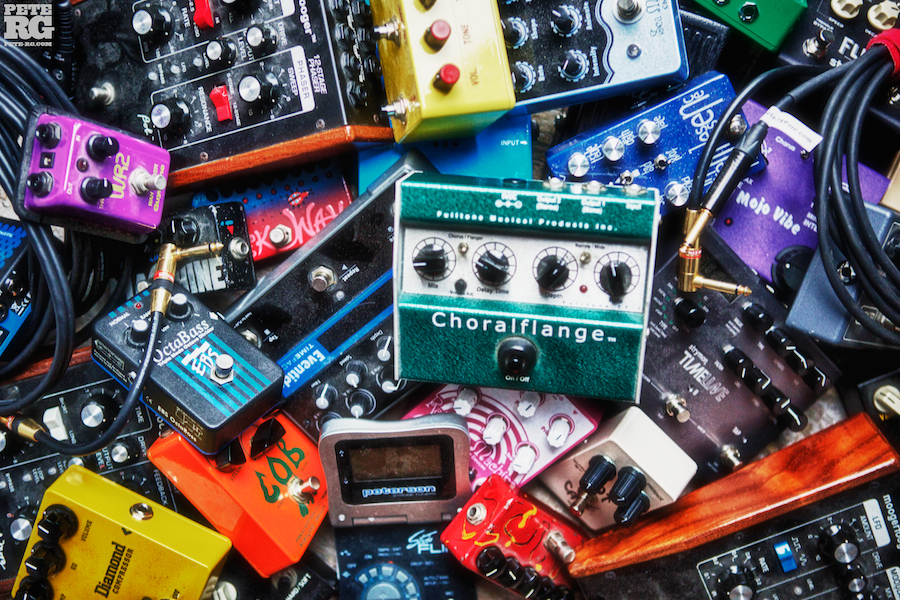 Greetings fellow pedal lovers of the world, welcome back to “Stomp School.” This month we’re going back to basics with some simple troubleshooting and maintenance tips that will keep your pedals healthy and keep you sounding your best. Most guitarists spend the majority of their time learning, practicing and performing with their instrument. This is as it should be. But if you play an electric, then a certain amount of time and attention is required to optimize your gear. Working all the knobs and switches is one thing, but occasionally more than basic operation will be required, especially with a larger rig that incorporates multiple pedals and effects.
Greetings fellow pedal lovers of the world, welcome back to “Stomp School.” This month we’re going back to basics with some simple troubleshooting and maintenance tips that will keep your pedals healthy and keep you sounding your best. Most guitarists spend the majority of their time learning, practicing and performing with their instrument. This is as it should be. But if you play an electric, then a certain amount of time and attention is required to optimize your gear. Working all the knobs and switches is one thing, but occasionally more than basic operation will be required, especially with a larger rig that incorporates multiple pedals and effects. Let’s start by going through a basic procedure for troubleshooting a setup with multiple pedals. Assume you’re at a gig and you suddenly have no sound coming from your amp, or even worse, the sound coming from your amp is a loud buzzing or some equally horrifying sound. You fumble around in sheer panic before deciding to plug directly into your amp, foregoing the aural delight of your effects for the evening. The problem was likely something fairly simple, and if not for the panic attack, you probably would have figured it out eventually. Here’s a quick and simple routine that will allow you to quickly pinpoint and address the problem, which should result in shorter down times.
“…problem-solving is often more difficult with the added pressure and excitement of a live performance than practicing in your living room or rehearsal space, when you have time to troubleshoot at your leisure.”
To begin with, it’s easiest to start troubleshooting backwards, from the amp rather than from the guitar. This may seem a little counter-intuitive to some, but since the sound you ultimately hear comes from the amp, that’s where you’ll want to start. Check the amp itself by plugging your guitar cable directly into it. If that works, then you’ve ruled out the amp, guitar, and guitar cable as the possible culprits. Now go ahead and plug your pedals back in. If the problem you’re having is that there’s no sound, pull the output cable out of the last pedal in the chain and touch it to see if you get a buzzing sound from the amp. If so, this indicates that you have signal going from the last pedal to your amp. Reconnect the cable and move on to the next pedal in your chain, using the same test—touch the plug that you pull out of the next pedal’s output jack. Keep moving up one pedal at a time through the signal chain until you locate the source of the signal loss problem, then you can determine what’s causing the loss of signal. It may be a bad or loose patch cord, a pedal with no power, or a bad switch.
For “noise” problems, you will want to plug the guitar directly into the input jack of the last pedal in the chain, and then move up one pedal at a time to find the noisy pedal or patch cord. You should hear a normal sound until you locate the pedal or connection that’s making the noise. It’s often just a cable plug that is not fully seated or a little dirty. It could also be a sick pedal—we’ll discuss troubleshooting noisy or malfunctioning pedals in our next segment, but if you’re in the middle of a gig you may just want to put the problem pedal aside and deal with it later.
This little routine we’ve just outlined may seem elementary to some of you, but we’re surprised at how many pro-level players still find themselves in the above situation—lost as to what to do. There’s also the “firing line factor”: problem-solving is often more difficult with the added pressure and excitement of a live performance than practicing in your living room or rehearsal space, when you have time to troubleshoot at your leisure. “Rehearsing” your set up, breakdown and troubleshooting process during your down time is a great way to make sure you’re fool-proof under fire during a gig.
Finally, if you don’t do so already, it’s a good idea to put together an emergency utility kit to bring along to your gigs. Here’s a quick list of items you’ll want to include:
Extra batteries (even if you use a power supply, in case a power supply dies)
An extra power supply (Boss-type 9VDC wall wart)
An extension cord and a power strip
Extra guitar cables and short patch cords
Screwdrivers (flat and Phillips head)
Wire cutters/strippers
Small handheld volt/ohm meter
Duct tape (good for broken battery covers, bottom plates shutting)
Gaffer’s tape (not the same as Duct tape; it is easily removed. Ideal for taping down wires, set lists, and posting notes)
Electrical tape
Scissors
Cable tie wraps